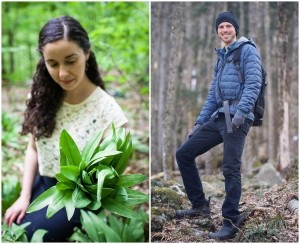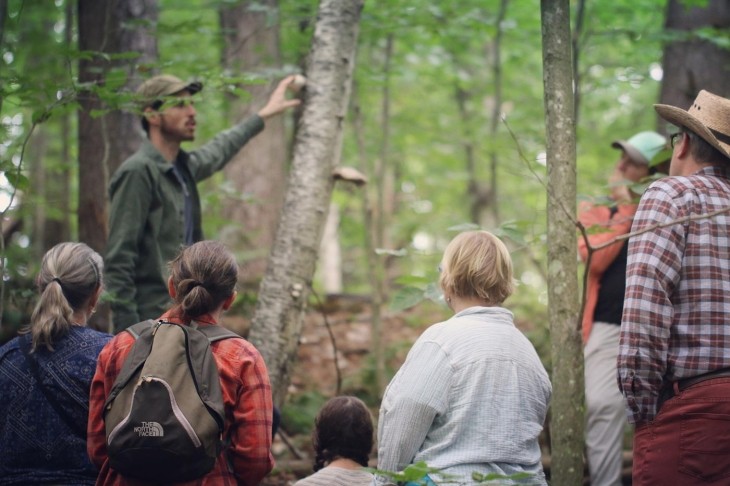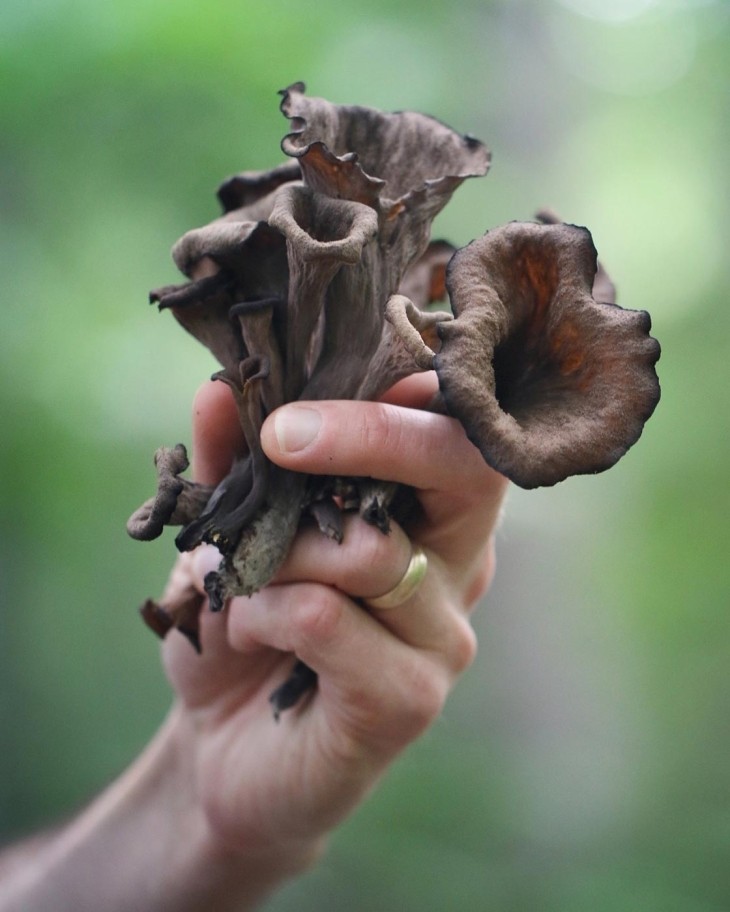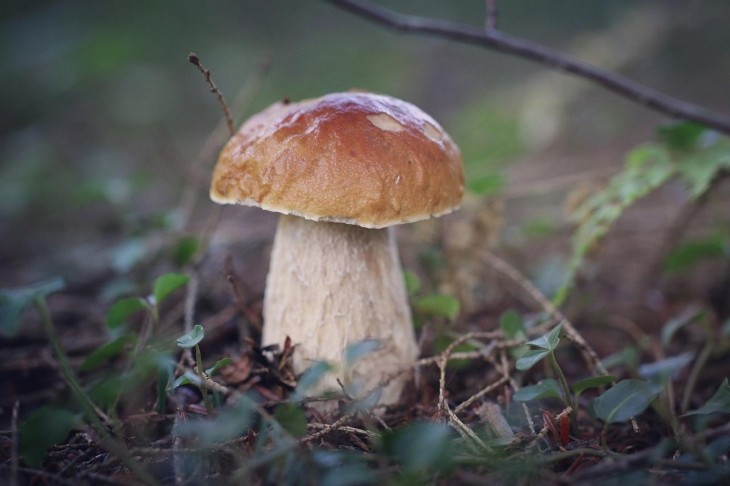
Jenna Antonino DiMare and Ari Rockland-Miller have been exploring the woods since they were children. Originally from western Massachusetts’ Pioneer Valley, the married couple met in high school and have called Vermont home for more than a decade. In 2010, they founded The Mushroom Forager, and they now lead many mushroom forays each year. Ari also works for the Vermont Agency of Agriculture, Food and Markets in the field of land use permitting. Jenna also directs the Vermont Green Building Network and the Burlington 2030 District, with a goal of reducing building energy consumption, water use, and transportation emissions. They live in the town of Richmond.
What are some of your earliest memories of spending time in the woods?
Ari: I would just kind of ramble around my parents’ property. We had some hemlock forest, about 5 acres of land, but it felt massive as a kid. I would explore and find amphibians – and mushrooms. I would pile wild mushrooms I found on the hood of my parents’ car and just marvel at the diversity of shapes, sizes, and colors. I got my first field guide – the National Audubon Society Field Guide to North American Mushrooms by Gary Lincoff – when I was 10 years old. When I was a little kid, we went on a whitewater rafting trip on the Deerfield River as a family, and there was a mycologist on the trip. We stopped for lunch along the river, and this mycologist found a big flush of oyster mushrooms. So we took home a lot of oyster mushrooms and ate a bunch and froze some. That is one of my early memories of eating wild mushrooms.
Jenna: The forest was my favorite place to explore as a child. My earliest memories are of pretending to be a chipmunk, jumping on old stone walls. I have always been a naturalist, although the specific interest in and passion for wild mushrooms stemmed from Ari’s genuine enthusiasm. But my passion for food has been long standing. I grew up in a family of cooks and learned to cook at a young age. I began cooking dinner for my family once a week starting at the age of 9. So it was a natural fit for me to enjoy collecting gourmet edible mushrooms in the forest for the table. There’s more story in your meal and more meaning when you’re using food that you’ve grown or foraged.
When and how did the idea for The Mushroom Forager emerge?
Ari: In 2009, I was managing a forest farm called the MacDaniels Nut Grove on the Cornell campus, which was part of a research project led by Dr. Ken Mudge. There was a mushroom research project there, where we were growing shiitake mushrooms on hardwood logs and exploring the optimal species of wood and cultivation methods. I already had an interest in mushrooms, but I became truly obsessed. I saw wild chanterelles that were growing spontaneously in the nut grove, and I was fascinated. I started talking with any mushroom experts who would talk with me and reading every book I could and just adding one mushroom to my list at a time that I felt comfortable ID-ing. I started with the more distinctive mushrooms, really mastering the ID and the look-alikes, then slowly building my way up from there. Then we started this blog.
Jenna: Ari was talking everybody’s ear off about wild mushrooms, and our friend suggested we start a blog. Ari and I had a few late nights dreaming of this project where we would share about our adventures hiking and hunting for mushrooms in the forest, and The Mushroom Forager was born. We were amazed by the readership that we quickly harnessed. That fall, we were invited to teach a workshop in Vermont, so we drove from Ithaca, New York, to Vermont to lead our first workshop. We’ve led hundreds of programs since then to thousands of mycophiles from around the world. We lead mushroom hunting workshops that foster a sense of wonder, with an emphasis on edibility, ethics, ecology, safety, and sustainability. It’s been a lot of fun and truly our pleasure bringing people out into the forest and showing them ways to look at the forest with new eyes. Once you put on your forager eyes, it’s hard to turn them off. It’s the ultimate fun treasure hunt that we can enjoy as adults, and it really brings about that childhood sense of wonder, which I think is a real treat.
How are mushrooms and trees connected?
Ari: Mushrooms are very intertwined with trees, and learning about how to ID mushrooms requires the knowledge of tree ID as well. If someone was to find what they thought was a hen of the woods (Grifola frondosa), but it was on an ash tree, for example, it’s probably not a hen, because hen of the woods really is pretty specific to oak trees. In the case of chicken of the woods (Laetiporus sulphureus), which is an entirely different mushroom, it could be on a variety of hardwood substrates. However, a chicken of the woods on a hemlock tree is not recommended for consumption, even if it’s properly ID-ed, because it’s a distinct species (Laetiporus huronensis), which can cause gastric upset in many individuals. People really value their wild mushroom spots and, in many cases, keep those spots kind of secret. A good spot can last for decades or generations. Often it’s a gift that keeps on giving, once a year, in the right season, with the right timing – provided that the trees that are intact. If you cut down the trees, that’s going to likely harm the mycelium of mycorrhizal fungi underneath those trees as well.
How risky is mushroom foraging? Do you worry about toxic look-alikes?
Ari: We’ve never gotten sick from any wild mushrooms we’ve eaten, because we’ve always been very cautious and mastered the identification of one species at a time – developing complete confidence, to the point where identifying that mushroom becomes like recognizing a good friend or a family member. But when you’re first learning, it’s easy to confuse various look-alikes, and it is imperative to be safe in how you approach this. There are parts of the world where the culture is mycophilic, and people learn how to forage as children. This is true of eastern Europe for sure, as well as France and Italy, and also true of China and Japan – and that’s not an exhaustive list. Here in the U.S., I think many of us have historically come from a perspective of mycophobia. While it is wonderful to see burgeoning interest in foraging here in North America, it is also important to recognize that there are deadly mushrooms that are quite common in this region at certain times of the year – such as the destroying angle (Amanita bisporigera). The stakes are simply too high to take any risks, so we encourage learning one species at a time, starting with the most distinctive. It can be very safe if you’re prudent and do your homework and are always 100 percent certain before taking a bite. When in doubt, throw it out, or take a photograph for further study.
Could you describe the programs you offer through The Mushroom Forager?
Jenna: We lead workshops, typically starting in May, that have a spring edible plant and early spring mushroom focus. The majority of our educational programs take place July through early to mid-October to align with peak mushroom hunting season, and convey our passion for the topic in a way that is accessible and engaging. We lead both in-person workshops and private guided mushrooms forays, and a couple of years ago we also launched a Mycophile Membership program featuring a six-part online mushroom hunting class series that spans the Northeast mushroom hunting season. So, from May through October, we host a once-a-month online mushroom class that folks who live in the Northeast can join. It’s an interactive class – we share what we’ve been finding in the woods, I share what we’ve been cooking in the kitchen, and Ari will feature charismatic fungi of the month, and then we answer questions. This year we have people participating from eight states.
Ari: We have a variety of venues and organizations we work with to host forays, including Vermont Audubon, Shelburne Farms, Green Mountain Club, and several land trusts and farms throughout the state.
What are some of the ethical considerations of foraging?
Ari: We always recommend people never pick more than half the patch, so leave at least half in the ground – or leave more, in many cases. It’s important to remember that mushrooms are the fruiting body, while mycelium is the underlying organism. So if you carefully pick a mushroom, you’re not killing anything. It’s more analogous to picking an apple off a tree. With that said, it is important to be mindful of harvesting ethically, because mushrooms do contain spores, which are new DNA that can start new patches and foster resilience of the species in light of climate change, deforestation, and other factors. We also encourage people, if they are going to harvest an edible wild mushroom, to harvest a mature fruiting body as opposed to a baby mushroom, because mature fruiting bodies have already distributed many of their spores. We also remind people to be mindful of the context, make sure they have landowner permission. And there are some spots where taking 50 percent could be way too much – if it’s a communal area where other people are also going to walk.
Do you have any favorite wild mushrooms?
Ari: One of my top ones is the porcini. A truly pristine porcini is rare in the summer – it can be very slug infested. But in the late fall or at higher elevations, if you find a pristine porcini – it’s called Boletus edulis, and edulis means edible – it’s the quintessential edible mushroom. It’s large, chunky, firm, nutty – really delicious grilled or sautéed. This time of year, we adore morels, although they’re very hard to find in our region. All wild mushrooms should be cooked – morels are a good example of that, because they are toxic if raw. We love black trumpets in the summer. Black trumpets are really special, with a fruity, fragrant aroma. Golden chanterelles are also special for similar reasons.
Jenna: Hen of the woods in the fall is one of my definite favorites. It’s an incredible mushroom that can be sautéed or roasted. It has an amazing umami flavor, and whenever we have the pleasure of finding a beautiful hen, my mouth just waters. They’re so delicious. We also love lion’s mane, and oyster mushrooms are outstanding roasted as well.
What else do you forage, besides mushrooms?
Jenna: Ramps are most certainly our favorite spring green, and probably my favorite plant that we forage. To me, it’s a sign of spring when we go out for our annual ramp ritual in mid to late April and do our first harvest of the season.
Ari: I would say mushrooms are our foremost passion. I love the unpredictability of mushrooms, the constant challenge and treasure hunt element of it. They’re invisible – the mycelia are underground or in the wood, so until they fruit, it’s hard to know whether or not they’re there, beyond reading the habitat. So there’s always a sense of surprise and wonder when you go to a spot and see a sea of chanterelles that were not there at all a week ago. I love berries, too. In the summer, I pick wild strawberries, and blackcaps (black raspberries), which come in late June, are one of my favorites from my childhood, so they are kind of nostalgic. Wintergreen berries are a fun one, especially in the winter months, because they stay sweet and minty all winter – actually the cold makes them even sweeter. And I enjoy tenkara, a form of fixed line fly fishing that originated in Japan, which gets me through the month of June, which is not quite as good a month for mushroom hunting. And in the peak mushroom season of August-September-October, sometimes the very streams on which I pursue the brook trout are also great spots to look for mushrooms, along the stream banks – the hedgehog mushroom, golden chanterelle. I enjoy both fishing and mushroom hunting in the same outing.
Do your children forage with you?
Jenna: Absolutely. They are both genuine mycophiles. They love to go mushroom hunting with us, and when we get home to cook mushrooms in the kitchen, they both savor the mushrooms. They truly love going out into the forest with us and looking for mushrooms. It has been really sweet to witness their passion for mushroom hunting – and their skill level to find, for instance, the little black trumpets that start fruiting in July and August. With their smaller stature, it’s easier for them to find black trumpets. They also are able to identify some of the deadly and toxic mushrooms, which is important.
Ari: They have good eyes. Obviously, we always double-check everything that goes into the basket. Our 9-year-old is definitely getting to the point where she has a number of mushrooms that she can identify with quite a bit of confidence. It’s wonderful to see that. Mushroom hunting is a way to appreciate the forested landscape and is another non-timber forest product. I think an ethical mushroom hunter can play a net positive role in the forest ecosystem by fostering stewardship and fostering an appreciation of the forested landscapes and watersheds that are so important to human and environmental health.




